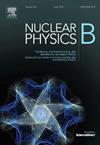A compact stellar configuration via gravitation decoupling and minimal geometric deformation
IF 2.8
3区 物理与天体物理
Q2 PHYSICS, PARTICLES & FIELDS
引用次数: 0
Abstract
The present study reports an investigation of a minimally deformed solution from class one solution embedded into five-dimensional pseudo-Euclidean space, which is the four-dimensional space-time, through a gravitational decoupling approach. Applying the minimal geometric deformation approach, we have obtained the embedding class one solution to the field equation of the interior space-time. Furthermore, the study reported a reconstructed and deformed spherically symmetric metric by deriving a new set of solutions for the extra anisotropic source acting on the field equations. Furthermore, considering the impact of additional sources, the effective density and pressure in tangential and radial directions have been reconstructed in this study. Finally, the arbitrary constraints and required parameters have been evaluated for some realistic compact objects by applying some matching conditions. Alongside accessing the effective density and effective pressure, a causality analysis was conducted to reveal that the model is stable under the purview of the additional source. The study has observed that the stability and equilibrium of the system attain their maximum value around the center and maintain a positive level throughout the core of the star objects as a result of an increase in the anisotropic component. The mass-radius relationship and gravitational redshift have been assessed and confirm that the chosen compact objects are unique types of neutron stars and ultra compact objects for our model, and moment of inertia has been analyzed in this study.
通过引力解耦和最小几何变形的紧凑恒星结构
本文研究了一类解嵌入到五维伪欧几里得空间(即四维时空)中的最小变形解的引力解耦方法。应用最小几何变形法,得到了内部时空场方程的嵌入类解。此外,通过对作用于场方程的额外各向异性源的一组新的解,本文报道了一个重构和变形的球对称度规。此外,考虑附加源的影响,本文还重建了切向和径向的有效密度和压力。最后,通过应用一些匹配条件,求出了实际紧凑物体的任意约束条件和所需参数。除了获得有效密度和有效压力外,还进行了因果关系分析,以揭示该模型在附加源范围内是稳定的。研究发现,由于各向异性分量的增加,系统的稳定性和平衡性在中心附近达到最大值,并在整个恒星天体的核心处保持正水平。对质量半径关系和引力红移进行了评估,确认了我们模型所选择的致密天体是中子星和超致密天体的独特类型,并分析了本研究的惯性矩。
本文章由计算机程序翻译,如有差异,请以英文原文为准。
求助全文
约1分钟内获得全文
求助全文
来源期刊

Nuclear Physics B
物理-物理:粒子与场物理
CiteScore
5.50
自引率
7.10%
发文量
302
审稿时长
1 months
期刊介绍:
Nuclear Physics B focuses on the domain of high energy physics, quantum field theory, statistical systems, and mathematical physics, and includes four main sections: high energy physics - phenomenology, high energy physics - theory, high energy physics - experiment, and quantum field theory, statistical systems, and mathematical physics. The emphasis is on original research papers (Frontiers Articles or Full Length Articles), but Review Articles are also welcome.
 求助内容:
求助内容: 应助结果提醒方式:
应助结果提醒方式:


